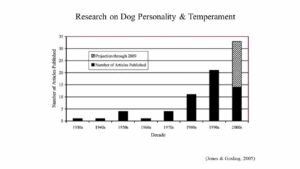
The old chart above was used by Sam Gosling PhD to demonstrate science’s early reluctance to look at animal personality or dog personality as a serious pursuit. If they were reluctant to research personality they were doubly resistant to study how animals play.
There are now numerous books and publications that talk about animal play. The seminal author on the subject Marc Beckoff defines play initially, by saying “Play is all motor activity that appears to be purposeless…” Play can be categorized as social or non social. Social play can be with your own kind or with others outside your species, non social play involves objects, toys and the environment.
I like to think of how play evolves in children. With a structured game the child evolves from their desire just to play without purpose and slowly evolve into purpose like “winning”. A very young child makes two or three moves and declares themselves the winner! Over time they allow more rules into the play and slowly move from loose rules to strict rules and fairness. The parent (handler) moves from free engagement to competitor. Your dog needs this same evolution.
In a survey and subsequent publication I coauthored, we asked federal detection dog handlers to identify traits that their dogs displayed that the handlers believed were related to the dogs’ success. The survey data showed that handlers agreed that most of the traits measured by the standardized assessment test were in fact important; however, they brought up additional measures they considered important, including “playfulness.”
Play in the detection dog is both social and nonsocial. Socially the dog is in a game of hide and seek with the handler, where the handler can give the dog clues and opportunity, but relies on the dog’s ability to find the hidden toy, The nonsocial function of play is the dog’s desire to find and possess the toy. If the toy is not self motivating and self rewarding the dog can lose the desire to find and keep the reward.
I will post a video tomorrow of a program participant learning to play with his young dogs. In the meantime, think about your play. Is it purposeful or is it free form?
The above referenced study is found at https://img1.wsimg.com/blobby/go/2e9bfa90-f232-4a9f-8a90-34c16a86c887/downloads/2014%20Field%20survey%20vs%20breeding%20selection_.pdf?ver=1573270762781

